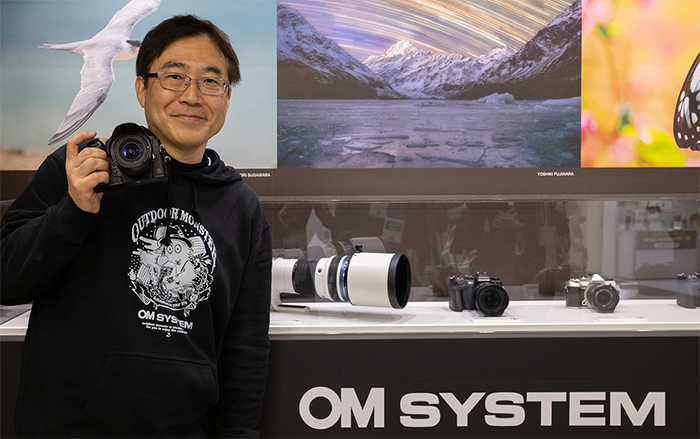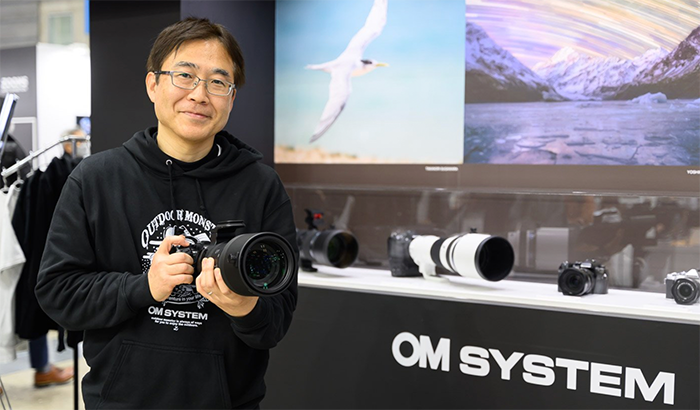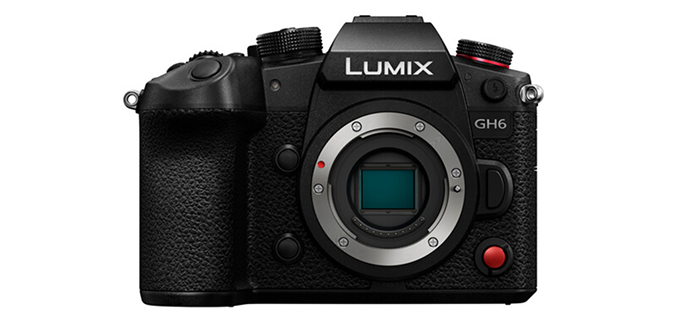Thom Hogan thoughts about the Olympus PEN pro (a must read!)
The latest rumor about the Olympus PEN pro cameras created a very long and interesting discussion on 43rumors (Click here to read the original article including the 160 comments). Thom Hogan from bythom.com added his personal thoughts about Olympus PEN pro future. I believe he made a very understandable and rational analysis of the risks, limits and chances of future Olympus PRO cameras. Let’s read the text and discuss the single points!
The following text has been written by Thom Hogan on 43rumors:
Olympus PEN pro
At one end we have pros trying to shoot action or events in indoor venues. Typical need: ISO 6400 at f/2.8. At the other end you have pros trying to produce enough pixels to stay competitive in the high-priced ad/high end editorial realm. 24mp is already there and feeling a bit wimpy against the MF offerings, and for outdoor work, dynamic range is the name of the game. Then there’s the pro need for wireless flash and studio light control.
A working pro currently has 14-24mm, 24-70mm, 70-200mm, all f/2.8 in FX which would require a 7-12mm, 12-35mm, and 35-100mm f/1.4 in m4/3 to be fully equivalent.
When you look at the market that way, even the best step forward Olympus (or Panasonic) can take forward is still a step backward from what a pro is currently shooting with except for one thing: size and weight (and yes, I’m assuming you can match autofocus, buffer, dual card, and a host of other features).
The problem as I see it is that “pro” for Olympus means a niche within a niche. I don’t know any working pro that wants to take a step backward from where we are in terms of dynamic range and noise, and even drawing the sensor development line out three generations I can’t see m4/3 getting to where the D3s is today. ([shoplink 20760]Click here to see the Nikon D3S specs[/shoplink])
Thus, Olympus would have to aim narrowly in terms of “pro.” Something rugged enough and convenient enough with enough quality to get a pro to consider carrying it all the time instead of a compact camera. It’s certainly possible, but as I noted, it’s a niche within a niche.
The target Olympus should be shooting at (and considering their history, should have shot at FROM THE BEGINNING) is the serious enthusiast. They want quality, control, ruggedness, flexibility, but they also want small and light. I can’t tell you how many people love the D700 but for one thing: it gets big and heavy after awhile. ([shoplink 20761]Click here to see the Nikon D700 specs[/shoplink])
Olympus is running a small survey of registered users right now. It’s very interesting that their questions show that they don’t get it. For example, here’s one question: “Why did you purchase the PEN and NOT a point-and-shoot camera?” Note the perceived bias in the question itself (the provided answers to rank don’t help, either). Gee, I was one of the nth names that got the survey, but I didn’t purchase my PEN in place of a point-and-shoot camera. How do I answer the question reliably? The questions in the survey show that they think of their users monolithically, instead of in sub-groups. Remember, their initial marketing for the E-P1 was dedicated towards bloggers and the Internet savvy looking to move up from a compact camera. It appears they’ve never gotten over that position. ([shoplink 16884]Click here to see the E-P1[/shoplink])
And then there’s the two-year thing. Sony is going up-scale with the NEX-7 (or is it the NEX-9, I get conflicting reports?) within a year. That could put a huge hurdle in Olympus’ path, as we all know how well the Sony APS sensors are performing right now. Fortunately, Sony doesn’t get the lens needs, so Olympus still has a chance.
The best way to think about this is to use a time machine and go forward a few years. In 2014 Olympus would need a line of four or five PENs to remain competitive, I think. It needs something below where the [shoplink 18844]E-PL2[/shoplink] is now, something at the US$399 price point and probably 16mp. At the other end it needs something that is built tougher than the [shoplink 14830]E-P2[/shoplink] with a built-in finder and weatherproofing, but no bigger and heavier than the E-P2 is now, and probably 24mp, certainly no less than 18mp. Bridge those two with other models (E-PL3 and E-P3). The consumers are already well served by the lenses that exist, so virtually everything in the lens list between now and 2014 should have been enthusiast-level glass. Oh, and the camera has to communicate (and not slowly through an accessory as big as a flash sitting in the hot shoe ;~). But I’ll bet that this isn’t what we’ll see by 2014.
Olympus PEN pro Questions and ansers:
Thom answers to 43rumors readers questions:
> Olympus only needs to shoot ISO1600
But this does point to the problem with m4/3: lenses. Without the right lenses, it would be hard-pressed to compete at the professional level. Olympus sort of got this with 4/3, but then there they produced a great set of lenses for what turned out to be mostly lower-end cameras (recent [shoplink 17163]E-5[/shoplink] notwithstanding). I see a lot of equivocation in design decisions (and not just on Olympus’ part, as most camera makers are making similar strange decisions; Nikon hasn’t produced a wide DX prime despite making DX for 12 years, and much of that time with pro bodies in the lineup).
> Wouldn’t f/2 suffice?
Yes, it very well might, especially if we substitute enthusiast for pro as the target. But the thing that I’ve felt that Olympus has missed so far is that a lot of their lenses don’t match their bodies. That makes selling systems a lot more difficult. The current 14-xx zooms and even the [shoplink 14818 ebay]9-18mm[/shoplink] and the [shoplink 15861 ebay]75-300mm[/shoplink] do indeed tend to fit the E-PL2 profile pretty well. But they don’t fit the E-P3 or Pro Pen profile particularly well, which means Olympus needs a range of new lenses as well as that high-end body.
> More likely that m4/3 gets better sensor before Sony gets lenses
Sorry, but I wouldn’t agree with that assessment. Sensors run at a fairly predictable pace in terms of improvement, and even two generations of Panasonic sensor improvement is only going to get them to the current Sony APS level under the best of scenarios (and, of course, Sony wouldn’t be standing still). Lenses are a different story, and given Sony’s opening the mount, we’re going to see plenty of lens choice soon, I think. In one case you’re betting on one company making unheard of performance improvements (Panasonic sensors) and in the other case you’re betting on multiple companies using known tools to create known entities (lenses). You’re betting on the wrong horse.
> APS lenses are big
Not necessarily. The Sony kit lens isn’t much bigger than the Panasonic kit lens. The primary reason the Olympus kit lens is smaller is because it uses a collapsing system. There’s nothing stopping APS from using collapsing designs, too. As a matter of fact, you apparently aren’t aware of the [shoplink 20762]Samsung NX100[/shoplink] kit lens, which is a collapsing zoom that’s remarkably small for APS. Be sure you’re looking at the right variables. Remember, we had 35mm film lenses that were smaller than many of the existing digital lenses ;~).
> Weatherproof Pen. Camera side fixed.
No, it’s not quite that simple. Enthusiasts want to hold cameras to their face and see an optical view, so a built-in viewfinder is a must, even if it has to be EVF (but see X100). There are probably a couple dozen small tweaks that are necessary that aren’t present, too. If Olympus were to contact me directly, I’d be happy to define those for them ;~).
Moreover, the further we move into the digital age, the more workflow becomes a big issue to the enthusiast. The sneaker net thing has got to go away (card out of camera into card reader, software ingest program moves them). That, too, is a camera design issue.
Your lens choices are reasonable, but I would argue that you need a 12mm, 25mm, and 45mm prime set, too.
So one camera body and six lenses, all targeted to the high-end enthusiast would suffice.
> [shoplink 20763 ebay]Leica X-1[/shoplink] and now the [shoplink 19929]Fujifilm X100[/shoplink]
One thing the retro designs prove is that cameras weren’t “broken” back in the film days. We do have more things we need to control these days (e.g. white balance), but subsuming controls down into a menu system wasn’t the right approach. Direct control works just fine. Spraying those controls all over the body doesn’t work: you have to think about the user’s hands and where they are while shooting and what they’re doing. A lot of people (and most camera companies) miss one subtle nuance in Nikon’s DSLRs: the button-dial interface is designed so that your index finger is ALWAYS over the shutter release. Your thumb is on the rear dial, your middle finger on the front dial. Most buttons then are on the left side (different hand) or within reach of the right thumb or middle finger. The impact of that is this: once you know where the buttons and dials are and are comfortable with that, you never take your eyes from the viewfinder and you never take your shooting finger off the shutter release. In other words, you stay connected to seeing and reacting to the moment.
> grip needs GPS
No. I’d vote against this. The camera needs to communicate. Communicating to a GPS is just one thing it could do. Those of us who carry iPhones with us already have internet access, GPS, and more. What we want is the ability for our camera to take advantage of that.
Thom answers to a readers PRO feature list
> 1. Reliability.
Needs to survive heavy, rough travel and weather.
> 2. Accurate, large and bright viewfinder.
A high proportion of enthusiasts are eyeglass wearers. So I would add “needs flexible eyepoint and diopter”. Also, once we get into EVF, large and bright aren’t as important as fast refresh and enough pixels.
> 3. Good grip.
I’d rephrase this: “Close attention to creating functional shooting position.” And that needs both small hand and large hand consideration.
> 4. Good battery life.
Even more important since we’re using the LCD (and possibly EVF) a lot. There’s a corollary: EVF use shouldn’t lower the number of shots per charge (it currently does, and by a considerable margin).
> 5. High resolution LCD screen with accurate color reproduction.
You won’t get the latter. Indeed, because you’re viewing in different light all the time, you can’t easily get the latter. That’s why I vote for “consistent color reproduction.” The bigger concern with the LCD is viewability in all types of lighting conditions, and a sub-concern: stop using anti-reflection spray-ons that wear off.
> 6. Quick access button to things like custom white balance.
This goes with your #13, which I’ll drop. Instant access to exposure mode, drive mode, focus mode, aperture, shutter speed, ISO, and white balance. Quick access to aspect ratio, image quality, metering, flash settings, perhaps one or two others. FN button access to user defined things.
> 7. Superb dynamic range at base ISO.
Unfortunately, this plays against the m4/3 sensor size. It’s a bit like asking for more horsepower in a four-cylinder engine the size of the old VW Beetle’s. Moreover, dynamic range is related to low light performance, as both are measurements related to shadow noise. So you could say, for instance: emphasize low noise over pixels. Or pixels over low noise. But not both.
> 8. Good flash synch speed and 1/8000 shutter speed.
Flash is a whole ‘nother subject and needs its own discussion in m4/3 forums. I won’t go there at the moment. As for 1/8000, I’d vote no. I’d rather have built in NDs in the system.
> I rarely use any shutter above 1/4000″, but it’s nice to have when something comes up that requires it, such as a humming bird shot
Most successful hummingbird shots are done with flash, and shutter speed starts to be irrelevant for that, as the flash pulse IS the shutter speed.
> I hate flash, but when a situation requires it, you need it.
This is one of the reasons why I said that flash needs its own discussion. What I’m finding amongst mirrorless users is a high propensity AGAINST using flash. Getting flash specs too intricate is playing against the audience, I think. Of course, flash solves the small sensor problem, so there’s dissonance that needs to be resolved.
> 9. Weatherproof.
See #1.
> 10. Dust removal.
We need a landing zone for manual cleaning, amongst other things.
> 11. Not just the body is pro, but also the lens line up.
My point exactly. Two zooms, three primes. That’s all it will take. Get me from 24 to 200 in the zooms (that implies 12-35mm, 35-100mm to keep to the 3x rule of thumb), give me fast 24, 50, 85mm primes.
> 12. I don’t need fast autofocus, but I do need accurate AF.
Unfortunately, these sort of go to together. Faster AF makes for more accurate AF. But improving contrast AF is simple: run the sensor faster.
Thanks Thom for pasisng by on 43rumors! I hope Olympus will read the article!




